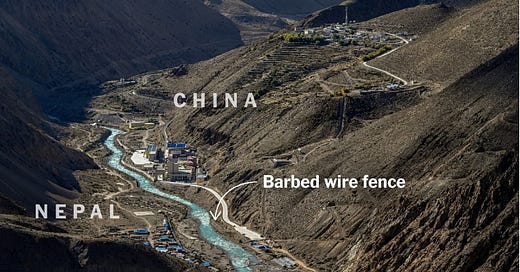China’s quiet incursions into Humla reflect a bolder regional doctrine
It is redrawing Nepal’s border—with concrete and Kathmandu’s silence
Image: Atul Loke for The NYT
From a distance, it resembles a public-works project. Up close, it proves otherwise. In the Humla district, along the thin air of the north-western frontier, China has built what amounts to a military-grade fence: barbed wire, floodlights, surveillance cameras and guard towers. Above it looms a 600-foot slogan carved into a hillside, praising the Communist Party of China, visible even from satellites. Few Nepalis were consulted. Fewer still seem willing to protest. (The New York Times first reported this.)
What is being fenced off is not only land. It is Nepal’s freedom to make its own choices. China has turned one of the Himalayas’ sleepiest crossings into a high-tech stage for silent domination. Beijing’s objective is not ambiguous: assert sovereignty; neutralise dissent; and close escape routes from Tibet. The methods, however, serve to blur the line between domestic security and international encroachment.
Humla used to be a corridor for Tibetan refugees fleeing religious repression. Today it is a containment zone. Crossings have slowed to a trickle. Ethnic Tibetan Nepalis report being harassed for displaying images of the Dalai Lama. Chinese personnel, uniformed or otherwise, reportedly enter Nepali territory without clearance. Surveillance hardware has been installed in areas locals believe lie within Nepal. No bilateral announcement preceded these activities. No official objection followed.
The government’s response has been one of studied indifference. A confidential internal report from 2021, obtained by The New York Times, confirmed Chinese structures had been erected on or near Nepali land. The report was buried. Requests to access historical survey maps were denied, even to sitting ministers, despite the maps being available in international archives. The joint border inspection mechanism with China, last active in 2006, remains frozen.
Asked to comment, successive foreign ministers have offered evasions or contradictions. Officials fear raising the matter could threaten trade flows, infrastructure funding or political goodwill from Beijing. In Kathmandu, as elsewhere, economic pragmatism is proving a poor substitute for strategic clarity.
The imbalance is clear. On one side of the border lies Tibet with paved highways, military outposts and full-spectrum surveillance. On the other lies Hilsa, a Nepali outpost lacking even basic road access. China’s build-up serves both civilian and military ends. Airstrips, model villages and logistic hubs dot the Tibetan plateau, which are dual-use infrastructure with little ambiguity. Nepal by contrast has built no such capabilities.
Local leaders have raised the alarm but to little effect. Jeevan Bahadur Shahi, a former chief minister in the Karnali Province, has accused the central government of wilful silence. Residents recount being intimidated for protesting Chinese movements or attempting to map disputed locations. In the absence of formal channels, grievances circulate informally—unverified but consistent.
The pattern is neither new nor uniquely Nepali. China’s activities in Humla mirror its actions along the Indian border, where skirmishes in Ladakh in 2020 turned deadly. Similar tactics have been employed in Bhutan, where entire villages have materialised in disputed territory. In the South China Sea military bases now sit atop coral reefs. Across all these cases China’s strategy combines facts on the ground with a narrative of innocence. State media insists China has never taken foreign land. The maps say otherwise.
The U.S. Department of Defense, in its 2023 China Military Power Report, described Beijing’s posture as increasingly “provocative and coercive”. That has not provoked much recalibration in Kathmandu. In private officials concede their leverage is minimal. China is now Nepal’s second largest foreign investor after India, a key source of infrastructure loans and an increasingly visible diplomatic actor. Calling out boundary violations, in that context, is seen as counterproductive, if not downright dangerous.
This silence comes at a cultural cost. Pilgrims once passed through Hilsa en route to Mount Kailash, a sacred Tibetan site. That traffic has dwindled. Religious freedoms have been constricted. China’s surveillance dragnet does not stop at the border. Tibetan Buddhism, historically a source of cultural exchange between Nepal and Tibet, is now treated as a threat vector by Chinese authorities. Nepali citizens living near the border are subject to scrutiny, on both sides.
None of this amounts to formal annexation. But the mechanics are familiar. Establish presence. Erect infrastructure. Suppress dissent. Wait. It is a strategy of gradual absorption rather than invasion. The methods are subtle, the effects cumulative.
China’s rise has been paved by railways and reinforced by roads. But it is also marked by fences: built silently and watched constantly as well as often placed where they were not before. The Humla district may appear peripheral to regional power politics. To Beijing it is a frontier worth fortifying. To Kathmandu it is a dilemma best deferred. But deferral is a policy with diminishing returns. In geopolitics, as in property, possession is nine-tenths of the law.
And possession, as Humla’s new fortifications suggest, is increasingly secured by concrete, wire and silence. ■



